Motorcycle tour of Colombia and Ecuador 2012
 This tour took me some very varied places. It was interesting to explore the rural parts of these beautiful countries. However no camera was brought on this trip, so I hope my words will be vivid enough to make the story enjoyable.
This tour took me some very varied places. It was interesting to explore the rural parts of these beautiful countries. However no camera was brought on this trip, so I hope my words will be vivid enough to make the story enjoyable.
First a summary to give you a taste of the adventure:
- Three weeks, starting April 16, 2012.
- Stopped and fined by police twice.
- Jumped on the street by police and searched for drugs.
- Pressure cooker heat mixed with numbing cold and a sprinkle of rain.
- Conquered a land slide and got interviewed on TV for it.
- Vast expands of nothingness makes you feel very small.
- Nothing beats the Andes for majestic views.
- Chain jumped the sprocket, but was fixed road side.
The story starts in Medellin, where I lived in an apartment in the Laureles neighborhood. I had recently acquired a Colombian driver's license and was ready for some serious riding. I found a Yamaha XTZ250, on/off road style motorcycle, which I bought second hand from a nice guy called Oscar. He conveniently bought it back from me after the trip.
The bike was outfitted with a top box and hand guards, and I brought along a small toolbox for roadside repairs. I tied a water proof gym bag on the passenger seat right next to the top box, and made sure to pack as light as possible.
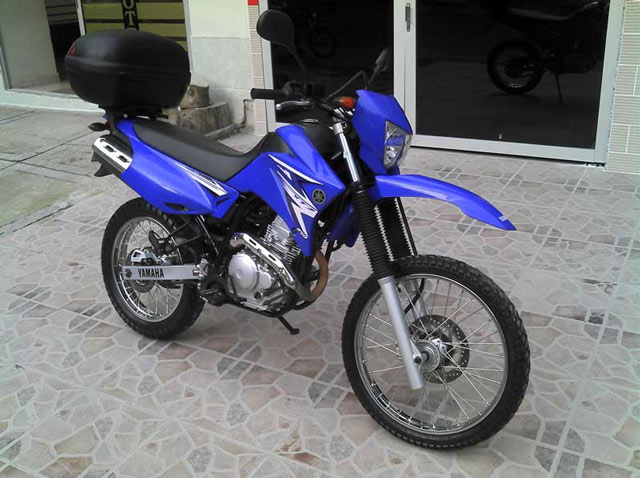
Below is an outline of the tour, which took me through most of Colombia and also northern Ecuador. My friends insisted on giving me advice and were a bit worried. Specifically they warned me about a city called Turbo near Panama, and to never go into the eastern flatlands/plains (Los Llanos), because of the risk of kidnappings and violence threatened by the FARC guerrillas.
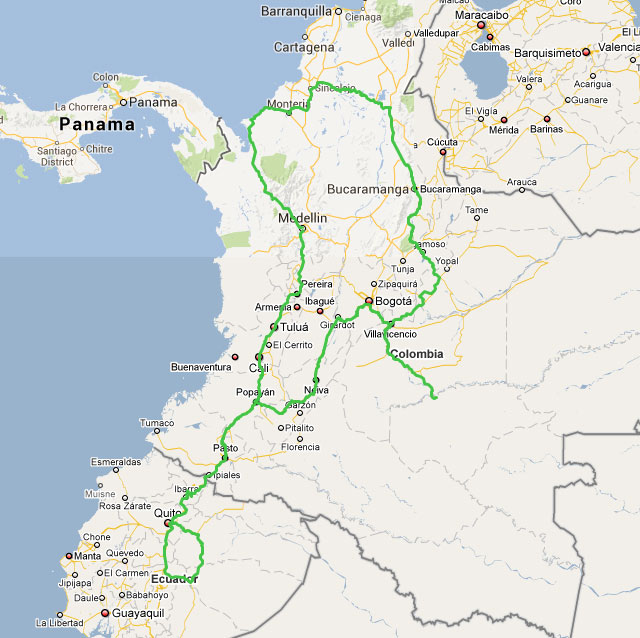
Western and Central Colombia
On the morning of April 16 I headed west out of Medellín. The road was beautiful, taking me through mountain passes and on many bridges across creeks. I came to colonial pearl Santa Fe de Antioquia late morning and had an empanada with apple soda, while I watched the old men playing cards and drinking beer on the main square.
I continued west through high mountain passes, on a very curvy road of varying quality. It had breathtaking views, with colorful small farms dotted in the landscape. Lots of potholes made the riding slow, with some parts lacking paving all together. After lunch in Dabebia Viejo I continued the twisty mountain roads through dense rain forest. Large portions of the road was covered by mud and rocks from landslides, barely pushed to the side by excavators. Soon I was down on clean flat land where I could ride faster, but unfortunately it started raining heavily. I pushed on and gave my gear its ultimate test.
Eventually I reached Apartado and checked into a cheap hotel. The village didn't look like much initially, but after an hour's stroll it grew on me. Low prices, no tourism and a palette of restaurants with good food.
Early next day I was in Turbo, the evil place warned about. I took a ride around the area but didn't see anything of interest. If anything it looked very poor.
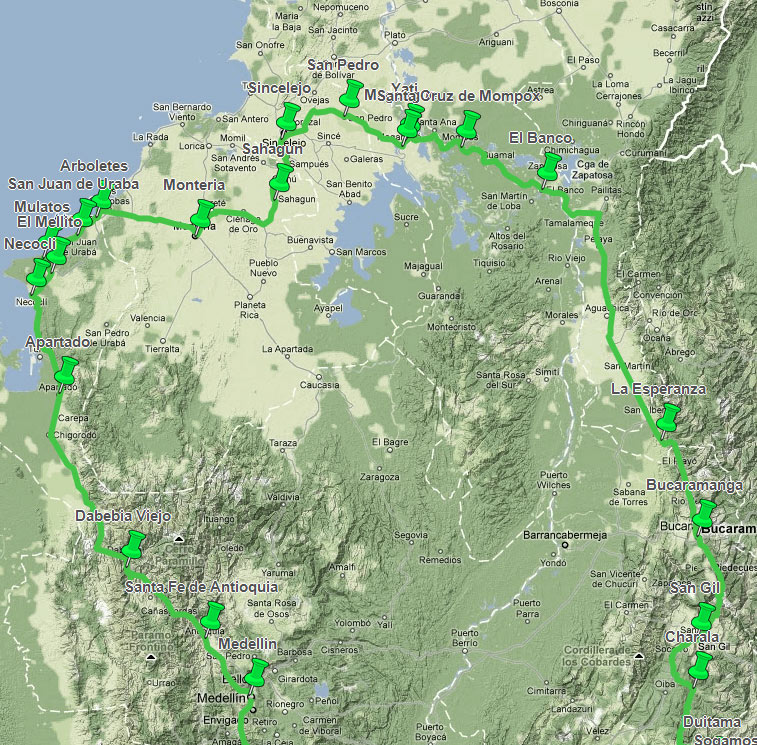
At Necocli the road turned into wash board style gravel. This got boring really fast. After two hours of riding a jack hammer, passing through forests and semi used land plots, I reached Mulatos on the Caribbean coast. I continued forward on tarmac again and passed through giant fields of plantains (platanos) and many cozy small villages, among them San Juan de Uraba and Arboletes. This was a really beautiful stretch of land, and I remember making a mental note about returning here again some day, perhaps buying a piece of it.
The road took me east into the mainland again. I had my eyes on Monteria, but it turned to be a quite unremarkable place, so I continued on. The road was lined with farms and small villages and quite enjoyable, and I eventually got to Sahagun and a hotel behind the main square. After a tasty but toxic pizza, I had to spend the night on the toilet. Luckily it was sorted out in the morning and I continued on.
This day my mission was to reach Santa Cruz de Mompox, a famous colonial style town. On the way I passed through Sincelejo, which didn't have much on display, but the road leading up to the next town of San Pedro was a fun ride on a long ridge overlooking a beautiful landscape.
To get to Mompox you have to take a ferry, and on the way to the pier you pass through Magangue, a bustling town with very active tradespeople. The place is a labyrinth of tiny alleys, packed with people and cars, and you get the feeling you can find everything and nothing here. I got stuck in traffic for a while but finally found my way to Yeti and the ferry pier. It was so nice to chill under a roof for a while, and eat lunch while waiting for the boat. The heat from the sun had been frying me all morning.
When the ferry arrived, the line of waiting vehicles had grown long. But they played a real life game of Tetris and pushed everyone on board; so tight you could hardly walk between the cars. I felt lucky to be on it. It was a nice cruise on the Magdalena river, which was so large it looked more like a lake. Cranes and other birds were busy finding food on the shallower parts. An hour later I rode off onto solid ground in La Bodega.
Here was the real back road country. Totally flat and with plantations, swamps and cattle pastures lined up along the road, it was an interesting ride and plenty to look at. It started on tarmac with two nice bridge crossings, but soon deteriorated into gravel. I ventured into small poor villages and pot hole filled, dusty dirt roads, mixed with long stretches that were flooded and hard to ride. Better be careful to not get stuck here!
I finally got to Mompox and immediately took a liking to its traditional style. Beautiful and old, but well maintained houses. I could see this had great tourism potential, but perhaps not yet ready for it, since few restaurants were open for dinner. I stayed for two days and relaxed. Through the town flows a part of the Magdalena river, with built up areas along the bank for strolling or sitting down to look at people. And the numerous cobblestone streets were very inviting to explore, with their shops and locals playing Tejo (throwing rocks at small gun powder charges). It was hot and humid though. Very much so. I got a taste of several local ice-creams.
Bucaramanga
It was time to continue east and eventually south. I loaded up my bike and was on my way. After a few hours I enjoyed newly paved tarmac running under huge trees giving a good shade to the ride. The sun was shining and I was flying ahead.
In the evening I entered Bucaramanga, a city not very different from Medellin; large, scenic and with perfect climate. I had plans to really explore this place, and potentially move here some day. I found a decent hotel downtown and settled in.
It was very nice. Especially the Cabecera area along Calle 33. This is a real city, not anything like the villages I visited so far on my trip, and it has a lot to offer. Modern big shopping malls mixed with local mom-and-pop-shops, and restaurants of all flavors. Bucaramanga also has a few blocks of really good motorbike shops, where I had a custom pair of rain pants made for me.
After finishing the lunch special at a local restaurant, I tasted the candy they gave me and put the wrappings in my pocket as I walked to down the street. Two policemen spotted me from their car, immediately pulled over, ran out and grabbed my arms. They were very hostile and talked fast. I could barely understand anything, except the word "drogas" (drugs). Apparently they thought the candy wrapping looked like a small bag of cocaine, and wanted to bust me. After learning about their mistake they simply took off, without an apology or anything. I was really pissed off and felt it was a poor welcome to their city.
After spending four days in Bucaramanga, I decided that this was a place worth returning to, but I was too curious about what was around the next corner to stay any longer.
Eastern Colombia and the Iguaque mountain pass
I headed south and found myself on an awesome road through the hills, the best riding so far. But there were plenty of trucks and they clogged up the road, so me and most other bikers would pass them even though we had to cross double lines. Not a good idea. A police spotted me and waved me in, or I should say reeled me in. I'm sure he had a lucrative business. $25 later I was on my way.
I arrived in San Gil, apparently a place I should have known about, because it was clearly post card material. Situated on a steep hill, it had lots of streets at a crazy angle, and a really nice colonial style square, all very well maintained and with a friendly vibe to it. It was obvious that this place attracted tourism.
After San Gil I decided to take a small back road for some adventure. I was about to head into the world of nothingness, so with somewhat nervous feelings I turned off the main road and onto gravel. There are very few road signs in Colombia, so you have to guess a lot at intersections, and then follow up with questions for the first person you meet. I entered this maze of gravel running through dense forest, and after a few wrong turns I eventually reached the oasis of Charalá. It was situated on a big stretch of open valley with cute small houses and a square with a church in the middle (can it be any other way in Colombia?) I had an empanada while the locals studied me at a distance like a zoo animal.
However I had barely just got started. There would be several hours more of this before I would be in civilization again. I entered the Iguaque National Park. The further I went, the more barren the landscape became, with fewer and fewer people. I asked some roadside locals if it was possible to continue, and they looked doubtful but said that with a bike like mine it could be done.
Soon enough I understood why: the road was really messed up with rocks and boulders. There was no way to pass even with a 4WD jeep. But with my nimble bike and some manual pushing I passed through. It was exciting but also felt like I was really far from home.
The road kept ascending into the tall mountains with steep drops along the edge. It got cold and I was also running out of gas. What to do if I get stuck here? Would I last the night without a tent or any kind of cover? Near the top of the mountain pass I saw a few people and their simple housing, and tried to buy gas, but no luck. I had all my clothes on, and I was shaking from the cold, and felt really small up there among the majestic mountains.
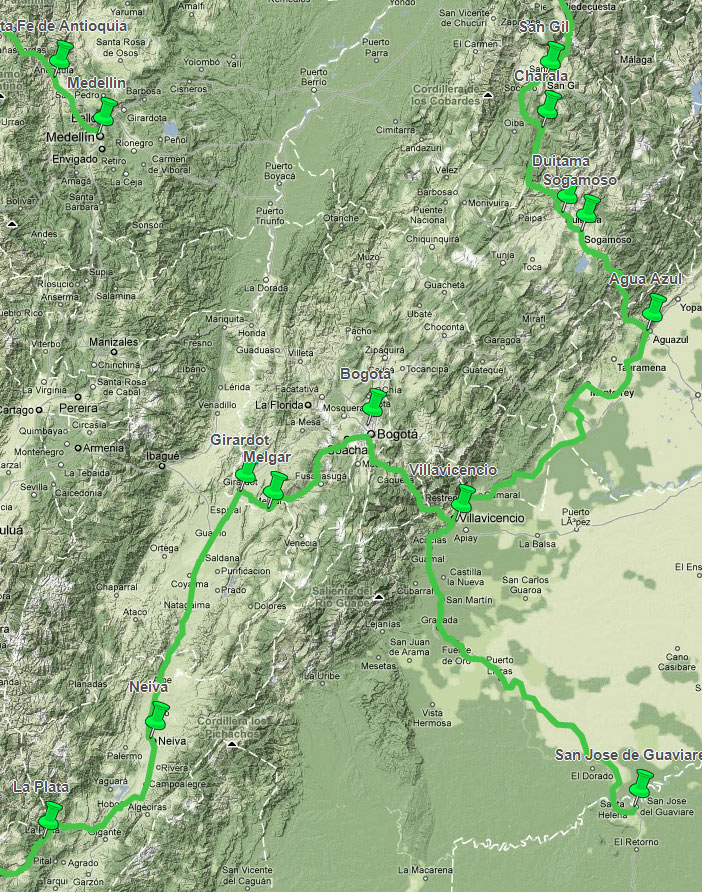
The nature was really different near the top of the pass. Almost no trees at all, just sturdy bushes, and weird spiky plants resembling pineapples, and a kind of flowers I have never seen before.
Soon enough I had reached the summit, and saw an amazing landscape in front of me. Dozens of mountain peaks at a far, far distance. It surely was humbling. I began my descent in this barren wasteland. One or two huts lined along the road, and the occasional communications tower, but nothing else. Just a windy, cold, lonely place with a great view. The few people I saw were all native Americans wearing ponchos, and looking at me with suspicious eyes.
It felt like an eternity of hairpin turns and there was Duitama and civilization again. I thawed up with a full meal of chicken and rice, and gave my loyal friend the Yamaha some much needed gas. It rained when I got to Sogamoso and I was exhausted, so after a hot shower and some pizza I immediately went to bed.
Landslide
Surprisingly I was fairly energetic the next morning, and ready for the next adventure. Another day, another mountain pass. So I headed south very early and it was uphill again. This time on a much better road.
The air was crystal clear and I could see hundreds of kilometers ahead as I passed the peak. On the way down, the road followed a beautiful river and all its curves in the terrain. The sun was shining and glimmering on the river and I enjoyed every turn.
Abruptly there was a stop, and I could see huge masses of dirt covering the entire road. There had been a landslide the day before, and now a few hundred meters of road was all covered with rocks, mud, rubble and trees. Dump trucks and excavators were busy clearing it up, but everyone could see this would take several days to finish.
I took a chance and tried to walk across the rubble. It was certainly possible to walk, if you were careful, but how would I get my Yamaha across? The workers told me to return and come back next week. What a bummer!
But I just didn't want to give up. So I gathered three guys and said "I'll give you 10,000 pesos each if you can help me carry my bike across the rubble." They looked doubtful but eventually decided to help me.
We started by lifting the bike along a steep slope, onto the mass of landslide. This already made everyone tired. Then we slowly pushed the bike while balancing it, and being careful to not get stuck on roots and other obstacles. At the other end was a balancing act along a ridge, and then downhill onto firm ground and it was done! Victory!
On this side was a TV crew interviewing people, because this landslide was obviously of local interest, and they promptly shoved a microphone in my face. I tried to explain where I was from and what just happened in my broken Spanish, to little success, so it was a short interview. Soon enough I was on the road again heading for Agua Azul, and then several hours later the busy city of Villavicencio.
The Flatlands
Villavicencio surprisingly turned out to be one of the trip's highlights. It sits on the foot of the mountain like a final outpost before the flatlands, much like Minas Tirith in Lord of the Rings, just waiting for the FARC creatures of the flatlands to attack.
It is a very nice city with lots to offer, with a bustling city core with a friendly feeling to it. A winding road takes you up the mountain in 10 minutes to marvelous views of the lands below. I spent three days here exploring the city and recovering from my previous adventures.
To go, or not to go, that was the question on the 29th of April. You can see on the map how lonely it looks, the way to San José del Guaviare. One would be crazy to go there, and what is there really to see, if anything?
Well, I couldn't keep myself away, it was just too interesting of a challenge. So off I went. Those were lonely and nervous hours on that road, this much I can tell you.
This place is not called flatlands (los Llanos) for nothing. It is FLAT. Initially cow farms as far as the eye can see, but eventually just a lot of nothingness. You get happy when you see a house beside the road, because it means someone can rescue you in case of trouble. I stopped about half way to get some food, and silently wondered why anyone in their right mind would want to live here. But the owner at least looked like a normal person and the food was tasty.
An hour later I found a gas station, what a luck! And then after a total of five hours I was in San José del Guaviare, the final outpost in this huge stretch of jungle. At the edge of the city was some heavy military presence, I suspect a deterrent for the guerrilla.
What shit hole, sorry Guaviarians. This place is as exciting as its Wikipedia page. Most roads downtown were not even paved. I stayed at the local hotel, and walked around town for a few hours, had some food, and decided to leave the next day. There was nothing scary about this place, just ordinary poor people doing ordinary things. And there was no excitement or opportunity either, just a place where nothing happens.
Feeling somewhat emboldened the next day, I returned to Villavicencio again. I took a short break in the city and then headed up the mountains westward towards Bogotá. The road was in great condition, with plenty to look at as it turned left and right to follow the river, cross over tall bridges and through tunnels. But also lots of trucks that slowed me down.
The area around Bogotá is enormous, and it is difficult to know how to navigate through. I'm sorry to say it, but it is cold, dirty and ugly in the suburbs. I had no plans to stay in Bogotá, and with a little help from fellow bikers I got on my way south and out of the city.
20 minutes out of Bogotá I got stopped by police again, this time an honest cop. I pleaded with him to not fine me, or at least accept an immediate cash payment so I wouldn't have to drive back to the city to pay it, but he refused. Eventually he tore up the fine and told me to respect traffic rules from now on. This was a huge surprise, I guess there is chance for Colombia to overcome corruption after all.
The road leading to Melgar was awesome, really pretty. Beautiful country side, idyllic. Melgar turned out to be a hot spot for the city folks in Bogotá, with lots of visitors everywhere. It had a very nice small town feel to it, mixed with plenty of hotels, restaurants and swimming pools.
At this time my eyes were set on Ecuador, so the next day I had to decide to take the big safe road via Cali, or the smaller via Neiva. Of course I went for the road less traveled, and hoped it would bring some excitement.
Early morning I reached Girardot, and a few hours later I was in the town of Neiva. It was decent but not that exciting. I pushed on.
After an hour of riding in rain I reached a river crossing with a bridge that was in really bad shape, with men repairing it. In the mean time all travelers had to go further down the river and cross by boat. Being the rainy season, the river was a torrent swelling to the brim. I watched as drivers and passengers had to go out of their cars to join pedestrians and motorcyclists and sit in over-sized canoes powered by outboard engines. The water flow was so strong that the canoes had to be at a 45 degree angle to be able to pass to the other side. Meanwhile a bigger boat was transporting the cars across, one at a time.
It all looked like madness to me, and I felt sure my bike would tip the canoe over and we would all fall into the river. They lifted my bike onto the canoe, I sat down with shaky legs, and tried not to think too much, and into the abyss we went. I watched the masses of muddy brown water passing by at a scary speed as the canoe wiggled its way forward, with one of the crew standing up to balance my bike. This seemed like just a normal day to them, and eventually we reached the safety of the other river bank.
Now the driver wanted 8,000 pesos from me, which really isn't that much. But since no other people were paying anything, I felt singled out and refused to pay out of principle. It became a heated argument, and I eventually compromised with 5,000 pesos, but out of pride he plainly refused to accept any payment at all. In the end I just left without paying, and wondered if this would get me into trouble later. Perhaps his buddies would wait for me down the road...
Finally I reached La Plata, high up in the mountains, like a forgotten place no one had heard of. It was quite charming though. Slow country life with beautiful views, lots of nature, and perfect climate. But it had the character of "nothing ever happens here", so I was keen to leave next morning.
This time I was on rough roads higher and higher up the mountains, along tall pine trees. Lots of potholes had to be negotiated. It was a fun challenge, almost like a competitive race through uncharted territory. But running into a pot hole and then immediately a sharp turn to the left, I suddenly lost control of the bike and it skid into the road gutter and I fell off. Luckily it was just a minor mishap and nothing got damaged.
I passed through dense forests with overcast sky and mist in the air, and no sign of people living or travelling through. This gave it a spooky feeling, almost like a fairy tale. Eventually it changed into sunshine and tarmac with a road that winded down through cozy villages. I hit Popayan, the city of white houses, in the late afternoon.
Southern Colombia
Popayán is a very unique place. The entire city center is full of old classical looking buildings, all painted in white. It looked like a very welcoming friendly place, and I decided to come back here some time in the future to explore it further. At this time I had become increasingly curious about Ecuador, so I continued.
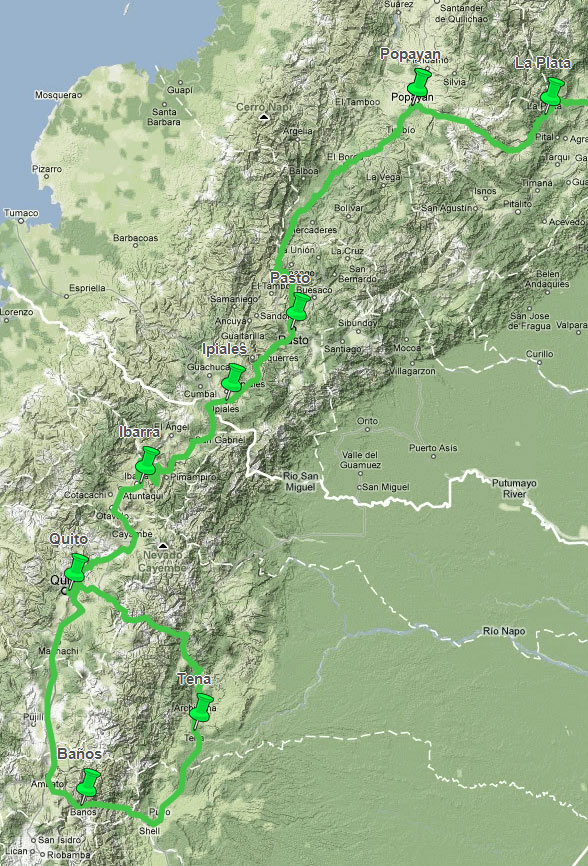
The road to Pasto was interesting. Extremely scenic, and through many different styles of nature; rain forest, tall mountains, agricultural areas, and deserts with lots of cacti. The road quality was surprisingly good, with few vehicles and lots of turns. One of the villages I passed through had only black people, which was strange, since the black population in Colombia typically are along the coast. I found my way to a hotel in Pasto and started preparing for the next day and Ecuador.
Further south along the road were huge plateaus carved out of the mountain in strange formations. I also noticed that the gas price had dropped to about half, a sign of contraband smuggling.
In Ipiales I went to the Ecuadorian embassy to get my papers in order. This was really easy and took just 30 minutes. It was overcast, with a drizzle of rain throughout the whole morning, but I was still in a good mood. They did a thorough inspection of my bike and luggage at the border, and finally I was in Ecuador!
Ecuador
Ecuador is not much different from Colombia, I quickly noticed. The same people and the same culture, but perhaps a bit more rural and cheaper. It also has more native American people. I drove through the city of Ibarra and was eventually in the suburbs of Quito, the country's capital.
It is hard to describe Quito. To begin with, it is enormous in size. Finding my way through the suburbs and into the city was a real challenge. There is a very nice downtown area, but the whole city has a gloomy feel to it with a cold climate and frequently overcast skies. It feels like nature is about to unleash its vengeance on the city for some reason. I stayed for two days and explored the old city center, but constantly felt I was freezing.
The next day I headed east, into the mountains again. This part really took the price for cold weather with mountain tops covered in snow. I had all my gear on in a desperate attempt to survive. It was an enjoyable ride though, on a well maintained road, but very few travelers in these parts. I drove past several industries, but could not figure out what kind, perhaps petroleum?
I reached the Ecuadorian flatlands and the city of Tena, where I stayed in an upscale hotel. Tena seemed to be an outpost for tourism in these parts, evident by the many tour companies and international food on offer.
I woke up early next day and saddled up for Baños, a place with great reputation. The road was along a big canyon and fairly nice. Traffic picked up, and I could see this was a popular place.
Baños de Agua Santa, or simply Baños, is a well known tourist hot spot, with outdoor activities like hiking, rafting and horseback riding. However I found the place unremarkable. Perhaps this was because of my prior weeks of exposure to fantastic scenery. Looking at the busloads of tourists, I decided to commit the heresy of not even stopping there, and pushed on up along the mountain. When a place gets too popular, I somehow get uninterested.
I thought for a long time about what to do next, and decided that I had enough of motorcycle touring for the moment. I might have had ridden down to Cuenca, and perhaps stayed there for a few weeks, but in the end I opted to head back to Medellín.
Heading back
The main highway going north through Ecuador was really great. Several lanes wide and newly paved, by US money as I understand it. I spent the night in Ibarra, and crossed over into Colombia the next day.
After a long riding session, I was heading up a slope at slow speed and hit a pothole and the motorcycle chain jumped off the sprocket. It had become slack with all the riding, and I had forgotten to tighten it up. My tools came to great use, and with a few friendly helping hands it got back on again.
I was back in Popayan again for an overnight stay, and enjoyed the nice climate for the evening.
I was curious about Cali, and found my way into its city center, but was fairly unimpressed by the congested streets, and saw nothing special on the way there. But given how large Cali is, it deserves a second visit.
The rest of the return trip reads much like a footnote, not much to tell. I wanted to get back home so I pushed on in high speed passing through Pereira and just outside Manizales.
Summary
Colombia and Ecuador are both great countries for motorcycle touring. There is even a fellow Danish guy who makes a living from it at Motolombia. Extremely scenic, since most of Colombia's population live in the Andes mountain range. But also very diverse in nature, scenery and temperatures. People are friendly and helpful, and food and lodging is cheap.
On the negative side, the local food tends to get boring fairly quickly, but usually there is international food available too. It can be a hazard to travel alone, unless you are street smart and know how to avoid danger.
